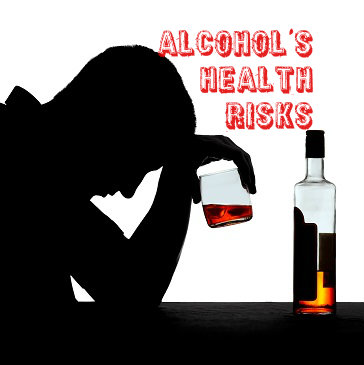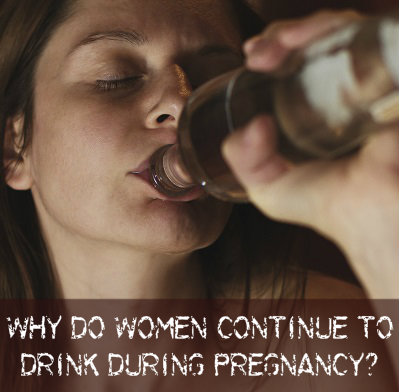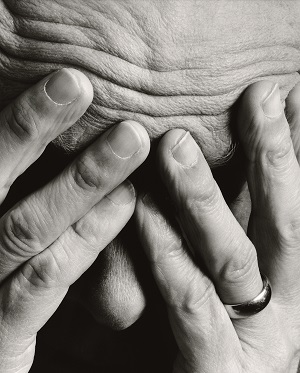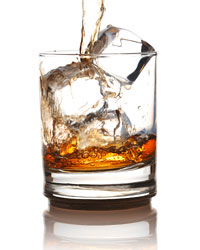Heavy drinking is a term used to describe a level of excessive alcohol consumption that steeply increases a person’s chances of developing alcohol use disorder (a condition which includes both alcohol dependence and non-dependent alcohol abuse). Fully 25 percent of all people who drink excessively meet the requirements for diagnosis of this condition. Heavy drinking can also increase the risks for other serious health problems. In a study published in 2013 in the journal Alcohol and Alcoholism, a team of Japanese researchers looked at the impact of heavy alcohol consumption on the risks for developing heart disease or diabetes.
What’s Considered Heavy Drinking?
According to guidelines issued by the National Institute on Alcohol Abuse and Alcoholism (NIAAA), the vast majority of people keep their risks for developing alcohol use disorder to a minimum when they limit both their daily and weekly alcohol consumption. As a rule, men minimize their risks when they consume no more than four drinks on a single day and 14 drinks in a single week. Women minimize their risks when they consume no more than three drinks on a single day and seven drinks in a single week. The NIAAA defines heavy drinking as any pattern of alcohol consumption that exceeds either the daily or weekly recommended amounts for men or women.
 Heavy Drinking And Alcohol Use Disorder
Heavy Drinking And Alcohol Use Disorder
Twenty percent of all adults who drink heavily once a month develop alcohol dependence (alcoholism) or clinically diagnosable alcohol abuse. Thirty-three percent of all adults who drink heavily once a week develop one of these problems, while fully 50 percent of all adults who drink heavily twice a week become alcohol abusers or alcoholics. The definition for alcohol use disorder comes from the American Psychiatric Association (APA). The APA once considered alcohol dependence and alcohol abuse to be separate concerns. However, in recognition of the highly linked nature of the two conditions, the organization officially acknowledged them as aspects of a single disorder in 2013.
Heart Disease And Diabetes
Heart disease and diabetes are both relatively common, potentially fatal chronic health problems. Common forms of heart disease (also known as cardiovascular disease) include coronary artery disease, stroke and heart attack. Some people affected by the blood sugar disorder diabetes have an often-inherited condition called type 1 diabetes; however, most affected individuals have an acquired condition called type 2 diabetes. Among other factors, risks for both heart disease and type 2 diabetes are associated with a buildup of fat in the abdominal region and an increase in a type of blood-borne fat called triglyceride.
Risks Produced By Heavy Drinking
In the study published in Alcohol and Alcoholism, researchers from Japan’s Hyogo College of Medicine used an examination of 21,378 men between the ages of 35 and 60 to compare the levels of abdominal fat and triglyceride accumulation associated with abstinence from alcohol consumption, light alcohol consumption, heavy alcohol consumption and very heavy alcohol consumption. They performed this comparison in order to estimate some of the diabetes- and heart disease-related risks associated with drinking. The researchers defined light drinking as intake of less than 0.78 ounces of pure alcohol a day. They defined heavy drinking as intake of anywhere from 0.78 to 1.55 ounces of pure alcohol a day. They defined very heavy drinking as any level of intake above 1.55 ounces of pure alcohol a day. In the U.S., a single standard drink of alcohol contains 0.6 ounces of pure alcohol.
The researchers found that, compared to both non-drinkers and other drinkers, very heavy consumers of alcohol have significantly increased risks for developing the abdominal fat and triglyceride increases that can contribute to the onset of heart disease or type 2 diabetes. They also found that, compared to both non-drinkers and other drinkers, light drinkers have significantly lowered risks for this body fat and triglyceride accumulation. In addition, the researchers concluded that, compared to very heavy drinkers who exercise regularly and don’t smoke, very heavy drinkers who smoke and fail to get regular exercise have substantially higher chances of accumulating abdominal fat and triglyceride. Conversely, light drinkers who don’t smoke tend to accumulate abdominal fat and triglyceride considerably slower than light drinkers who do smoke.
The authors of the study published in Alcohol and Alcoholism also concluded that all four groups of participants (non-drinkers, light drinkers, heavy drinkers and very heavy drinkers) had substantially higher chances of developing high blood sugar levels (characteristic of diabetes) when they had increased levels of abdominal fat. This finding indicates that an accumulation of abdominal fat boosts the risks for type 2 diabetes even when an individual keeps his or her alcohol consumption within recommended daily and weekly amounts.
See How Alcohol Use Among Teens Has Changed Over Time And Learn The Risky Alcohol Behaviors
A recent study estimates that close to 10% of pregnant women drink alcohol. Given the potential harm that can come to a fetus when exposed to alcohol during development, and the fact that vast majority of females at child bearing age were probably taught this at some point in their lives, this number is truly upsetting. Unfortunately, it’s also not shocking.
Some people still think that alcoholism (or other forms of addiction) is a moral failing rather than a bona fide medical disorder. Sometimes the impulse to drink can be so great that an alcoholic will put the importance of a drink over the safety and well-being of loved ones. It happens all the time with parents of young children, even when there is overwhelming evidence that the parent is a good person and truly loves their kids. Who doesn’t know someone who grew up in an alcoholic household? Is there any reason to think that the simple fact of pregnancy would be able to reign in such a terrible disease?
Condemning Addicted Pregnant Women vs. Helping Them Abstain From Alcohol
 Instead of chastising and condemning pregnant women who drink, we should be devising ways to help them abstain from alcohol during gestation. For hard core alcoholics, it is entirely possible that the only way to stop them from drinking for close to a year would be to physically restrain them. Barring that, however, there are things that we can do to try to reduce the incidence of drinking while pregnant.
Instead of chastising and condemning pregnant women who drink, we should be devising ways to help them abstain from alcohol during gestation. For hard core alcoholics, it is entirely possible that the only way to stop them from drinking for close to a year would be to physically restrain them. Barring that, however, there are things that we can do to try to reduce the incidence of drinking while pregnant.
We, as a society, must be more proactive in teaching people about the risk of fetal alcohol syndrome, a complication that can happen if a mother drinks while pregnant. People born with fetal alcohol syndrome will likely have abnormal faces, growth issues, and problems in the central nervous system. These issues will not improve over time and the neurological impairments can lead to learning disabilities and behavioral issues, like attention deficit disorder. Fetal alcohol syndrome affects up to 3 million people in the US alone.
The problem with teaching about the dangers of fetal alcohol syndrome is that evidence is murky when it comes to determining how much alcohol can safely be consumed before a fetus is put at risk. It used to be, at least prior to the 1980‘s, that doctors never restricted women from drinking alcohol during pregnancy. However, at some point the medical establishment changed its tune and soon no amount of alcohol was permitted during pregnancy. Now, conflicting information can be found everywhere.
How Exactly Does Fetal Alcohol Syndrome Happen?
Babies do not inherit fetal alcohol syndrome. Instead, the ingested alcohol actually damages developing neurons and destroys brain cells. The damage can occur at any point in fetal development, even before the mother knows that she is pregnant. Once the cells have been compromised, there is presently no way to undo the damage.
Educate Teens On Abstaining From Alcohol If Having Sex
Without knowing exactly how much alcohol is safe for fetuses, the only safe option for pregnant women is to avoid drinking altogether. Since drug-related birth defects affect not only the child but society in general, more resources need to be expended to help keep pregnant alcoholics sober during gestation and continually remind women of all ages about the dangers of exposing themselves to toxic substances if there is a chance they could become pregnant. Since alcohol and sex many times go hand in hand, it is a responsible and appropriate discussion to have with kids, especially given how prevalent substance abuse is in some sub-teen populations.
Addiction During Pregnancy – All Of Our Concern
In addition to increasing the amount of materials available to women of child-bearing age regarding the dangers of drinking, medical professionals in all venues need to be more vigilant in identifying mothers who are actively drinking or are at risk of developing a drinking problem during pregnancy. Although alcohol rehab programs have begun offering specialized treatment programs for addicted mothers, the number of available beds is woefully inadequate to handle the sheer number of people requiring treatment. Hopefully governments will begin to see addiction during pregnancy as a public health crises and funnel adequate resources into handling the disease. If someone you know is drinking during pregnancy, encourage them to seek help.
My story of addiction and recovery is the story of a near miss and an incredibly lucky break. Therapists talk about resilience and protective factors (as opposed to risk factors)—well, I had a boatload of risk factors but somehow I was able to muster some reserves, survive and ultimately thrive.
My story begins when I woke up from a blackout and realized that I had been raped. I remember drinking the night before, but I don’t remember anything from about halfway through the night until the next morning. The other people at the party helped me piece it together—what they saw and heard plus what I felt and what it all added up to. I was 13 years old and was already drinking myself into blackouts. The boy who raped me said he didn’t remember it either. He was only 14.
Within a year I was raped again, this time by an adult—the father of the child for whom I babysat. He was drunk. He was driving me home from babysitting his infant daughter, and made a wrong turn. I knew what was coming and just braced myself for it. I never told anyone.

Stopping One Addiction And Dangerously Starting Several Others
I stopped drinking but I didn’t stop trying to drown. I smoked marijuana, ate Quaaludes, black beauties, and pink footballs; I snorted cocaine, and eventually snorted heroin. I dated a dealer, and did anything I was handed, no questions asked. It came to me one day, an epiphany of sorts: I realized that if I continued to live the way I had been living that I would die. I had stopped short of using needles, but snorting coke and heroin wasn’t getting me high anymore. I had to escalate again, or get clean, or face the reality that life as a heroin addict-garbage head was likely going to kill me.
A mental health professional had said to me that women with my history end up either dead or in prostitution. For a 15-year-old, this was a pretty heavy realization. I wanted to talk with my mom about it, but when I asked her to talk with me later that day, she said no. I pressed her, telling her that I needed her to listen to me. “No,” she said, “I can’t listen to you.”
Pain, Molestation And Addiction At A Young Age
So maybe my story doesn’t begin at age 13 in a blackout after all. If by age 15 my mom couldn’t tolerate listening to me, obviously a whole lot more was going on and had been for some time. I started drinking when I was 12. I wasn’t the only seventh-grader who was drinking, but I was likely the only one who was drinking to deal with flashbacks.
Backing up another year, things had happened that I still struggle to name. Rape is too simple and it conjures up the wrong set of images. Incest is too familial and can’t capture the way it feels when it is your teacher. Yes, my teacher, my sixth-grade teacher.
There aren’t words for what he did; there are sentences. He was a pedophile, and he groomed me for months, setting me up to be in a position where I wouldn’t say no and I wouldn’t tell anyone. He betrayed my trust and he took my childhood at age 11. I loved him and he said he loved me. It was truly confounding. It went on for months, my lies to my mom about where I went after school, my first lies ever to anyone.
It was Lolita, so I’m told—a novel that no matter how wonderfully written it may be, I have never been able to read it. At the end of the school year, he disappeared. Eventually I told a friend, and she told my mom. Police were called, school officials informed. I was interviewed, and then interviewed again by a special police “verifier” to determine whether I was making it all up. I wasn’t.
Choosing Life And Healing In Recovery Over A Life Of Pain And Addiction
After spending the next few years trying to not feel anything, and then choosing to live instead of die, recovery was a very long and difficult road. Not drinking or drugging was relatively easy. Figuring out what to do with all those feelings and how to get my needs met in healthy ways was the real recovery. It took years of therapy, and a passionate will to “be better”—to not only stop trying to kill myself, but to actually enjoy living.
For a while, pursuing some sort of healing was a full-time endeavor. I chased healing and recovery, stalked it, pursued it relentlessly. I was vulnerable to healers of every make and model, and spent money I shouldn’t have spent and time I didn’t have seeking healing.
While I learned a ton and all of it was useful at some level, I think the critical moments were back in my teens when I chose—consciously chose—to live and to live well. I had no idea how I would make that happen, but it was adolescent spunk and contrariness that fueled my strength. Mom won’t listen to me? I’ll show her. In fact, a decent amount of “I’ll show her” propelled me forward through the hardest times. During that critical and vulnerable time, the anger and the desire to show my mom that I would get through this without her help was probably the single biggest protective factor I had going for me.
Reconciliation With Self And Family
Mom and I are reconciled now. We rarely talk about what happened—it is still a sore subject for both of us. Her pain at failing to protect me from a predator is a wound from which she’s had to heal. The rough ride through my teens is something I’ve had to move past—not easy when I was invited to witness teenage years all over again, ringside, as my daughter grew up. Now she is 19 and more whole and healthy than I think I ever have been, and while I can’t take credit, at least I can say with some relief—my past did not infect her.
At some point in my 40s, I stopped chasing down healing. Not that I declared myself finished with that project, but more to the point I realized that no one is ever fully finished. I am back on a level playing field. The challenges that were tossed in my path when I was young no longer haunt me and I am truly happy with my life. I’ve been through a few dark tunnels, and who knows, maybe more will come my way. But for now, for today, I can feel all I feel and deal with whatever comes my way. Life isn’t perfect, but it is good enough.
09 Oct 2013
Baby Boomers And Addiction – Part 2
Continued from Baby Boomers and Addiction – Part 1
There may be nothing specific to baby boomers that puts them at a higher risk of addiction, but their numbers will challenge the system. In order to adequately meet the need, new treatment approaches are being developed. The New York Times articles “Advice on Addiction in Boomers” Part 1 and Part 2, answer readers’ questions on the issue of addiction in this demographic.
Dangers Of Senior-Related Addiction
People in this age group will experience the greatest risk for alcohol-related health conditions such as heart disease, kidney failure, and liver disease. They also face the risk of falls and alcohol-related injuries that are made more severe by age.
Boomer-Based Approaches To Treatment
 While people are people and addicts are addicts, the Baby Boomers have always been, to some degree, their own animal. This has inspired new approaches to treatment and recovery designed to take characteristics of this population into consideration in developing more effective approaches.
While people are people and addicts are addicts, the Baby Boomers have always been, to some degree, their own animal. This has inspired new approaches to treatment and recovery designed to take characteristics of this population into consideration in developing more effective approaches.
Dollars and energy naturally go to preventing drinking and educating about alcohol related dangers in the teenage and college population, but statistically, they are not the problem. Older adults often fly under the radar with their problem alcohol use. They assume, by virtue of being adults, that they have their drinking under control. They drink more covertly, it is accepted in their social circles or they isolate and are harder to keep track of.
The question naturally arises: what is the likelihood of recovery for individuals in this demographic? Is it possible to reform after so many years of consistent heavy use or abuse? Is it possible to ‘teach an old dog new tricks?’
According To Dr. Krantz:
“The longer an individual uses a substance, the more changes there are to the chemistry and the neuro-pathways in the brain. The brain essentially becomes re-wired as a result of substance use. In recovery, with abstinence, those pathways can begin to heal, regardless of how long a person has been addicted. Despite the healing of the brain, the disease is forever imprinted, which is why recovery needs to be a lifelong process.”
Concerns Of Adult Children
Boomer alcoholics are raising levels of concern among their adult children—those old enough to recognize a drinking problem and motivated to help their parents find recovery.
Often it is the adult children of substance abusers who are questioning and confronting the disturbing habits and seeking out treatment information for their parents. Thus information and support directed at children on how to help or deal their addict parents will also be needed in coming years.
Societal Impact Of Treating Aging Addicts
The primary concern is increased health care costs as a result of the need to treat a large group of addicts with expensive residential recovery programs. While the past years have seen a decrease in binge drinking and alcoholic patterns in younger generations such as the Millennials, there has been a marked rise in the boomer-aged adults that have been admitted to the hospital for binge drinking, or who have needed medical treatment for drinking related conditions and injuries. Alcoholism also has the potential to exacerbate other pre-existing health conditions thus requiring a higher level of medical care and prescription drug use.
What Can Adult Children Do To Help Addicted Seniors?
Adult children can begin by becoming aware of what constitutes alcohol abuse. According to the piece in The New York Times:
“Several readers asked how to determine if a loved one has an issue with alcohol. The Centers for Disease Control and Prevention defines heavy drinking, or alcohol abuse, as ‘a pattern of drinking that results in harm to one’s health, interpersonal relationships or ability to work.’ Alcohol dependence, also known as alcohol addiction or alcoholism, is a chronic disease with symptoms including ‘continued use despite repeated physical, psychological or interpersonal problems.’
Some other important questions to ask are: Why is he drinking? Is it a coping mechanism? Is it about more than just liking the taste of alcohol? Is he drinking to relax? Is he drinking more than intended? Can he stop at any time and stay stopped?”
Warning Signs Of Substance Abuse
The article provided a general list of red flags to look for when questioning one’s own drinking problem or that of another.
These are some signs and symptoms that often manifest in boomers suffering from substance abuse or addiction issues:
- Drinking begins to interfere with relationships
- Decision making becomes more difficult
- Dementia or falling are more prevalent
- Increased tolerance
- More health complaints
- Chronic pain (it is important to seek treatment somewhere that specifically addresses this issue)
- Mood swings and emotional distancing
- Behavior that is out of the ordinary (for example, someone who plays golf all the time has progressive isolation and begins to give it up)**
If an addict is committed to practicing an addiction and refuses to seek help, there is often little that spouses, children, and/or grandchildren can do to make recovery a reality. However, all attempts and possible solutions should be exhausted. The coming years promise to bring new pathways and solutions in treatment and recovery with the aim of providing hope to baby boomers who suffer from addiction.
**Credit: List taken from The New York Times article “Addiction in Boomers.”
One of the hardest barriers to break through when confronting alcoholism is that of denial. Hollywood stereotypes alcoholics as bums with no home, no job and no family. Who would want to identify themselves as a person worthy of ridicule or pity? Very few and it may be what keeps so many from seeking help.
Universal Negative Effects
 The truth is that alcoholism affects people in every social, educational and professional sphere. This is a non-biased addiction. Finding the courage to admit the problem seems to be one of the greatest obstacles to turning things around. Alcoholics Anonymous meetings confront this hurdle head-on by requiring participants to stand before a group and name their problem – alcoholism. “I am an alcoholic” is a tough admission, but it represents the death of denial.
The truth is that alcoholism affects people in every social, educational and professional sphere. This is a non-biased addiction. Finding the courage to admit the problem seems to be one of the greatest obstacles to turning things around. Alcoholics Anonymous meetings confront this hurdle head-on by requiring participants to stand before a group and name their problem – alcoholism. “I am an alcoholic” is a tough admission, but it represents the death of denial.
The title “alcoholic” is one no one wants to wear and people will go to great lengths to avoid accepting the label. The alcoholic is a person who is not in complete control over his or her behavior. Those being ruled by alcohol may worry that they will sink in the eyes of others if they admit it, but that embarrassment pales in comparison to the joy of regaining control over one’s life.
Regain Control
The good news is that a person can regain control. The American Medical Association defines alcoholism as a medical and psychiatric disease. It goes on to say that alcoholism is considered a treatable disease. This is hope. Alcoholism is a beatable disease, it can be overcome. Life can be better.
A 2010 study found that more than 60 percent of people who recognize their problem with alcohol avoid getting help because of perceived stigma. Two-thirds of the participants in the study with serious drinking issues reported believing that alcoholics were stigmatized. They did not look for a way out of alcoholism because it would mean admitting they were alcoholics and that label carried too much baggage.
Courage in Recovery
The fact is that most likely those who might look skeptically at an admission of alcoholism are probably the very people who should be avoided. Those who care about the alcoholic will applaud the courage it takes to admit the problem rather than stigmatize him or her. As the person moves forward in recovery, it will matter less and less what others may think because the confidence that comes with being in control of life makes what other people think trifling by comparison. It is a terrible shame that health and well-being should ever be captive to misplaced perception.
On May 14, 1988, a drunk driver going the wrong way on an interstate highway just outside Carrollton, Kentucky, collided head on with a school bus full of children. In total, 24 children and three adults were killed in this horrific accident, making it the most deadly alcohol-related automobile crash in U.S. history. In commemoration of the 25th anniversary of this tragic event, on May 14of this year the National Transportation Safety Board issued a new report urging all 50 states to lower the legal limit of intoxication for anyone operating a motor vehicle from .08 blood-alcohol content to .05, a standard that is already in place in about 100 other countries around the world.
Referring to the approximately 10,000 deaths that occur in the United States each year in alcohol-related automobile accidents as “a national epidemic,” NTSB Chairman Deborah Hersman expressed her organization’s concern that the ongoing campaign to reduce drunken driving fatalities had reached a point of diminishing returns. The NTSB’s recommendation that blood-alcohol level restrictions for drivers be tightened is in accordance with the latest scientific findings, which show that a person with a BAC of .05 will experience “reduced coordination, reduced ability to track moving objects, difficulty steering, and reduced response to emergency driving situations” (quoted from a chart published by the National Highway Traffic Safety Administration). The NTSB estimates that if this new standard were universally adopted, it could lead to a 10 percent annual decrease in the number of people killed by drunken drivers, and it is urging the National Highway Traffic Safety Administration to offer financial incentives to any state that will agree to make the switch from .08 to .05.
Sensible Caution or Mindless Prohibition?
 As recently as the early 1980s, people who had been drinking were legally allowed to get behind the wheel of an automobile in many states as long as their blood-alcohol content did not rise above .15. But in response to rising public and political awareness of the true costs of drunk driving, legal standards began to evolve and by 2004 all 50 states had adopted the far more stringent .08 standard that still reigns supreme today. Since the heyday of .15, annual casualties from alcohol-related automobile accidents have dropped from 20,000 per year to just under 10,000, but drunken driving still accounts for about one-third of all highway deaths in the United States, more than any other single factor. Over the years, legal penalties for driving under the influence have become more severe in concurrence with the tightening of the BAC, and bars, clubs, and restaurants by all accounts have become more responsible about serving alcohol to customers who may be intoxicated. Nevertheless, drunk driving has remained stubbornly and discouragingly prevalent, and its consequences have continued to leave a long trail of broken bodies lying in the wrecked and smoldering ruins of crashed automobiles each and every year.
As recently as the early 1980s, people who had been drinking were legally allowed to get behind the wheel of an automobile in many states as long as their blood-alcohol content did not rise above .15. But in response to rising public and political awareness of the true costs of drunk driving, legal standards began to evolve and by 2004 all 50 states had adopted the far more stringent .08 standard that still reigns supreme today. Since the heyday of .15, annual casualties from alcohol-related automobile accidents have dropped from 20,000 per year to just under 10,000, but drunken driving still accounts for about one-third of all highway deaths in the United States, more than any other single factor. Over the years, legal penalties for driving under the influence have become more severe in concurrence with the tightening of the BAC, and bars, clubs, and restaurants by all accounts have become more responsible about serving alcohol to customers who may be intoxicated. Nevertheless, drunk driving has remained stubbornly and discouragingly prevalent, and its consequences have continued to leave a long trail of broken bodies lying in the wrecked and smoldering ruins of crashed automobiles each and every year.
Not surprisingly, the alcohol and hospitality industries have responded to the .05 recommendation negatively, calling it unnecessary, excessive, and bad for the economy. Others have pointed out that current laws already allow police officers to arrest drivers who appear intoxicated regardless of what their blood-alcohol levels might be, and they claim that the only people who will be taken into custody under these new restrictions will be those with BACs of .05 who show no actual signs of being impaired. Even some people involved in the fight against drunk driving have expressed skepticism about the idea of reducing the allowable BAC, believing that it will create a backlash that may ultimately hurt the anti-drunk driving cause by linking it to draconian laws that will not be popular with most people. Skeptics also argue that this new law would be all but unenforceable, since police would be expected to somehow know intuitively that drivers had reached the legal limit for intoxication and needed to be pulled over, even though in most cases their driving performances would appear to fall entirely within the range of normal.
The Power of Prevention
Some of these criticisms could very well prove to be legitimate, if the new standards are eventually adopted. However, government regulatory and safety agencies can only base their policies and recommendation for change on what the latest research shows, and in this case the science is clear: at .05 BAC the reflexes and perceptions of human beings are altered dramatically, and regardless of whether a person shows obvious signs of drunkenness, their ability to drive will be impaired if they have been drinking enough to reach this level of intoxification, thereby putting themselves, their passengers, and everyone else on the roadways at risk. While there may indeed be some backlash in the short-term against a move to .05, if there is any chance at all that such a move will discourage drinking and driving then this new proposal by the NTSB clearly has merit.
During the time when BAC driving requirements were being progressively tightened, from approximately 1980 through 2004, drunken driving-related casualty levels declined significantly and no one can reasonably argue that this is just a coincidence. Based on past precedent it appears very likely that these new recommendations will in fact be adopted at some point, and if and when that happens we can only hope that from then on fewer families will be forced to confront the premature loss of cherished loved ones as a result of a tragic—and entirely preventable—alcohol-fueled automobile crash.
19 Jul 2013
Without Screening Alcohol Abuse May be Missed
Patients come into a doctor’s office and give their symptoms to the doctor. The doctor listens, nods his head, and starts to piece together the symptoms the patient is mentioning and what he thinks may be the cause of those symptoms. But sometimes the patient doesn’t share everything with the doctor and the doctor does not ask some questions that could determine the causes or aggravations of an illness.
A new study from the School of Medicine at The University of Texas Health Science Center in San Antonio reveals that some questions doctors may not be asking are related to alcohol consumption. The article, in the Annals of Family Medicine, states that doctors may miss alcoholic symptoms in three out of four patients who come into their office.
 Screening Can Provide Proper Treatment
Screening Can Provide Proper Treatment
Researchers at UT Medicine conducted a study to see how well physicians could identify patients that exhibited symptoms of alcohol abuse. Over 1,600 participants were gathered from 40 primary care practices across multiple central states.
After participants were asked questions about their drinking habits, doctors were asked to make a diagnosis of whether or not the person was at risk for alcohol abuse. Participants were asked about the frequency that they drank alcohol and whether or not their drinking caused them to be reckless to themselves or with others. Doctors then categorized them in different alcohol use groups, including non-harmful drinker or harmful drinker.
Study co-author, Dr. Barbara Turner, stated that a doctor’s hunch missed identifying three out of four participants at risk for alcohol abuse. When doctors did suspect a person might be abusing alcohol though, the doctor was usually right.
Excessive Alcohol Consumption Hurts in Many Ways
Study authors believe that if patients were screened for their drinking habits that doctors may be able to help treat much more than alcoholism. High blood pressure, diabetes, liver disease, and some cancers have been connected to excessive drinking of alcohol. The 2011 National Health Interview Survey stated that over 85,000 people die each year from a circumstance where alcohol was misused.
Earlier studies reveal that when doctors have been able to identify harmful alcohol consumption habits in their patients, their patients decreased their alcohol consumption and improved their lives. Doctors provided brief counseling sessions to help their patients succeed in alcohol reduction.
Changing Procedures
Doctors can only treat what they see that needs to be treated. A screening procedure to help them identify a patient’s possible problems with alcohol use may help them better fully treat their patient.
Dr. Turner suggests that doctors screen their patients regularly to identify any changes in their drinking habits. A person may start drinking more heavily after both good and bad times like the following:
- Divorce
- Death of a loved one
- Loss of a job
- A new job or promotion to be social with new colleagues
- Celebrating with friends
If doctors catch harmful drinking patterns early, they may help prevent risky actions and future health problems in their patients.
The college years are filled with opportunities to compete. From academic contests to dorm room antics, there is a drive on campus to define hierarchies and social order. Even in college partying, where the scene may seem to be much more chaos and order, there are social ordering activities taking place. Drinking games are often used to show how a person handles alcohol or can retain their cognitive abilities while under the influence.
Previous studies have shown that engaging in drinking games can predict whether a college student will drink heavily. However, little is known about whether the type of drinking game will affect how heavily a student will drink. Recently a team of researchers examined various drinking games and their relationship to the drinking behaviors of college students (LaBrie, Ehret & Hummer, 2013).
The participants were recruited through two universities located on the west coast. They were invited to participate in a web-based screening. The researchers used the results to include only the participants who reported consuming at least one drink per week, resulting in 3,421 participants or 68.3 percent of the respondents to the survey.
The participants were asked about demographics, including whether or not they participated in the Greek system and also were asked about their drinking game activities. The researchers asked the participants how many days they participated in drinking games, the games played and the alcohol consumed on the occasions when the games were played.
Alcohol Games leading to Alcohol Abuse and Addiction
 To get an understanding of the various games the students mentioned, the researchers used the Internet to search descriptions of the games. There were 100 distinct games coded by the researchers, distributed into five categories.
To get an understanding of the various games the students mentioned, the researchers used the Internet to search descriptions of the games. There were 100 distinct games coded by the researchers, distributed into five categories.
The results showed that competition games were the most popular games, followed by chance games. The majority of respondents indicated that the competition games were also the games in which they drank the most alcohol.
Peak drinking games were reported differently by gender, race and Greek status. Students who were Caucasian males who participated in the Greek system were most likely to report peak drinking connected with competition games. The highest number of drinks associated with a peak drinking game was found to occur during extreme consumption games.
The authors note several limitations associated with the findings. For instance, the results were based on self-report and suffer the usual possible problems associated with recall bias. In addition, the question related to drinking games was open-ended and may have affected how the students responded.
The findings of the study provide new insight into the influence that the atmosphere and culture of a college campus and its traditions relating to drinking games may impact students’ drinking behaviors. It may serve to educate students about the risks of engaging in tempting competition that leads to heavy drinking.
Alcohol leads to more than addiction, but medical issues too. Read: Alcohol, a Preventable Cancer Risk ‘Hiding in Plain Sight’


